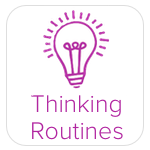- STEP 1: Have students begin moving around the classroom in their kinospheres (personal space). Then begin to cue students to move in specific ways, such as:
- Walk
- Hop
- Jump
- Skip
- Slide
- STEP 2: Students return to their basic walk as they move around the room. Instruct students that they will begin to change the pathways they are using to walk around the room- instead of moving in a straight line suggest students try:
- Moving in circles
- Moving in right angles
- Moving in a zig-zag
- Moving in a curved line
- STEP 3: Students return to their basic walk as they move around the room. Next instruct students to utilize different levels as they walk around the room.
- Crawl to show low levels
- Lay on the floor in a shape to demonstrate a low level
- Walk on your knees at a middle level
- Crouch to show a middle level
- Jump into the air to show a high level
- STEP 4: Students return to a basic walk around the classroom. Have students play with the elements of direction and time to change the way they are moving.
- Walk backwards slowly
- Walk to the right in slow motion
- Walk up the “stairs” fast
- Slide back and forth quickly
- Hop forward 3 times very slowly, then hop to the side 3 times fast.
- STEP 5: Students return to a basic walk around the room and practice moving in locomotor ways vs. non-locomotor ways.
- Stand in place and kick each leg
- Skip/jump
- Twirl in place
- Hold hands with a partner and move in a circle
LESSON IDEA:
Use this warm-up to practice moving around the classroom and showing expression while practicing dance vocabulary. Connect this vocabulary and expression to composing a story. Use the movements to guide the story arc.
EXTENSION:
Have students use this warm-up to practice the elements of dance as a way to discuss mathematical relationships. Consider having a student lead these warm-ups after the teacher demonstrates.
 |  |  |
